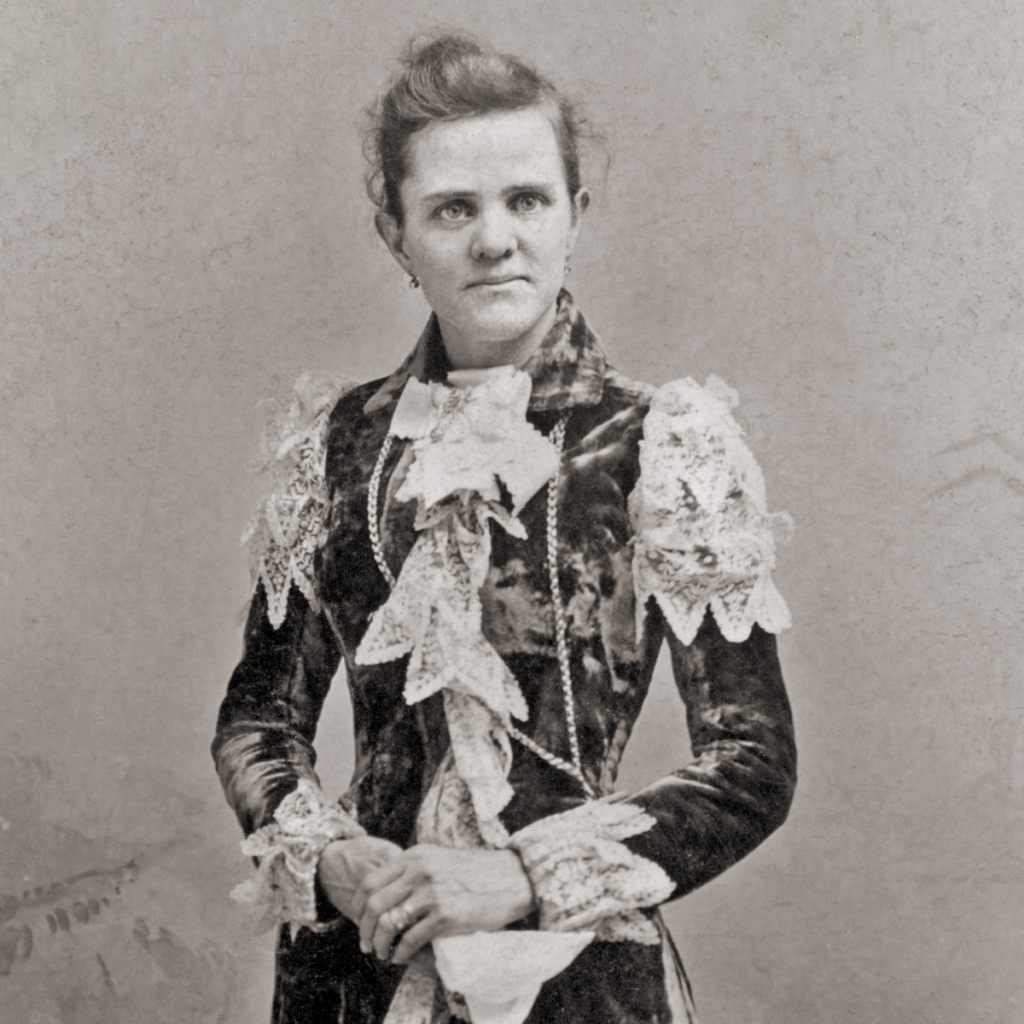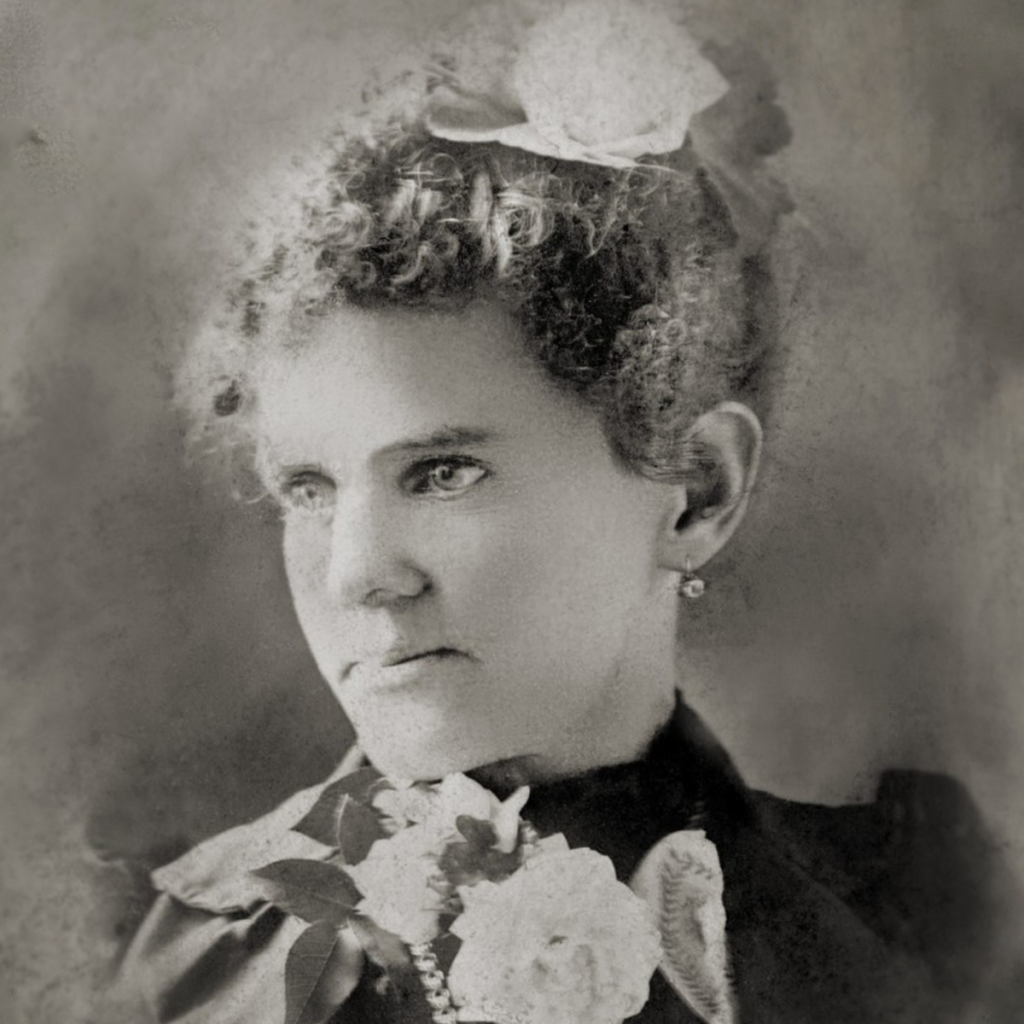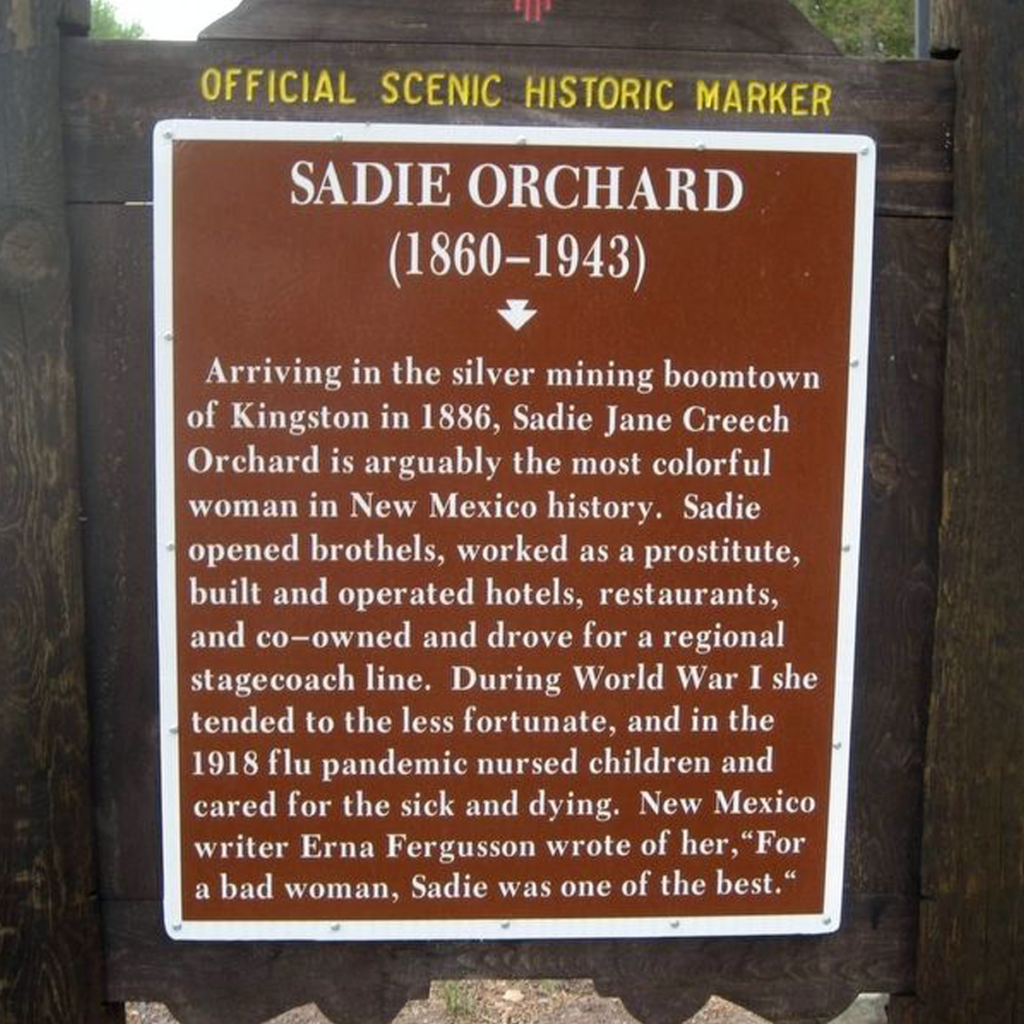Sarah Jane Creech, “Sadie” Orchard.
Sarah Jane Creech, “Sadie” Orchard
1860 - 1943
Sierra County
While her life and lifestyle are open to speculation, she was a central figure in the economic development of southwestern New Mexico during the mining boom of the late 1800s. An enterprising businesswoman, she was also a caring member of her community. “For a bad woman, Sadie was one of the best.”
As with many colorful and charismatic historical characters, history and legend have entwined with Sadie Orchard, producing widely varying accounts of her life and lifestyle. While conflicting information and interpretations of her life can complicate her biography, she remains a fascinating subject. Without a doubt, through her real estate holdings, hotels, and business ventures, she was a key figure in the economic growth of Kingston and Hillsboro during the mineral boom of the late 1800s.
Born Sarah Jane Creech sometime around 1860, she apparently told people she was born in London—and many early histories of her give life attribute London as her birthplace—but most likely she was born in Iowa. Regardless, by her own account, “Sadie” arrived in Kingston in 1886. Kingston at the time, along with nearby Hillsboro, was benefiting from the mining boom spreading through the mineral-rich Black Range District. The late nineteenth century was a time of economic growth for the region, and Sadie’s story is best understood against that contextual backdrop. The region offered opportunity for an enterprising individual such as Sadie to make a living. As Sadie herself described it: “At that time, Kingston was a mining town of about 5,000 population with a big silver boom going full away. Dance halls and saloons did a rushing business almost day and night. Fortunes were made, and in some cases, lost overnight.”
Sadie reportedly either opened a bordello in Kingston, or might have worked as a prostitute herself or for someone else. She comported herself as a gentlewoman, wearing fine clothing, despite her use of coarse language. She spoke of her own character in a Works Progress Administration (WPA) interview, stating, “I’m a product of the ‘Old West,’ and you know in those days we didn’t have much chance to practice the refinements and niceties of high society.” One story that emerges of Sadie during this time is that she took up a collection among the men who frequented her bordello to help build a church in Kingston. Another story persists that Sadie once rode her horse naked down Hillsboro Main Street on a bet. It is difficult to confirm either story today.
Around 1886, Sadie moved down the road to Hillsboro, only ten miles away and the county seat of Sierra County at the time (the seat was moved to Truth or Consequences in 1937). In 1899, the Sierra County Courthouse in Hillsboro, a tall brick building on a hill overlooking the town, would become the site of the renowned trial of Oliver Lee and Jim Gilliland for the murder of lawyer Albert Jennings Fountain and his five-year-old son Henry. She likely continued her work as a prostitute, at least until she met her husband.
Married on July 17, 1895, together the Orchards operated the stage line that delivered passengers and mail between the towns of the Black Range District and surrounding region, chiefly Hillsboro and Kingston, but also including Lake Valley—a town about seventeen miles south of Hillsboro where a silver strike in 1878 had caused a boom as well. The line also traveled an additional thirteen miles to Nutt Station, the terminus of the Atchison, Topeka, and Kansas railroad. Two relay stations along the route between Kingston and Lake Valley allowed for a change of horses.
Sadie spoke of her work in a WPA oral history: “Mr. Orchard and I drove the stage line for 14 years. We had two Concord coaches and an express wagon. I drove four and six horses every day from Kingston to Lake Valley and sometimes as far as Nutt station. In those days we did not have the roads we can justly boast of in New Mexico today, and my trips were surely trying—especially through the picturesque Box Canyon between Kingston and Hillsboro.”
In 1896, the couple opened the Ocean Grove Hotel in Hillsboro, which included a restaurant. Given that Hillsboro was the county seat, the hotel saw a number of politicians and lawyers in town for trials, business, etc.—especially during the Fountain murder trial. The Orchard Grove Hotel later became the Black Range Museum.
When she and her husband divorced in 1901, her husband left Hillsboro and she remained, tending to the Ocean Grove Hotel and also opening a second, the Orchard Hotel. According to some histories, she also opened her own brothel in town and ran it for several years. Photographs exist in the collections of the Photo Archives at the Palace of the Governors in Santa Fe of women believed to be some of Sadie’s “girls.”
Author Erna Fergusson describes Sadie’s care of her fellow townspeople: “During the flu epidemic she nursed many a family until all had recovered or died, washing, cleaning, cooking, laying out the bodies, lining the board coffin, and coming home to cut the geraniums and bleeding hearts grown in her dining-room window for just such occasions. For a bad woman, Sadie was one of the best.”
Sadie Orchard died April 3, 1943, in Hillsboro, and was buried in Truth or Consequences.
Sadie Orchard died April 3, 1943 in Hillsboro. She is buried in Truth or Consequences. The Orchard Grove Hotel later became the Black Range Museum.
Sources:
Birchell, Donna Blake. Wicked Women of New Mexico. Charleston, SC: The History Press, 2014.
Chavez, Thomas E. New Mexico: Past and Future. Albuquerque: The University of New Mexico Press, 2006.
Fergusson, Erna. New Mexico: A Pageant of Three Peoples. New York: Alfred A. Knopf, Inc., 1964.
L’Aloge, Bob. Pistols and Petticoats: 13 Female Trailblazers of the Old West. Los Lunas, NM:Flying Eagle-Thunderhawk Enterprises, 1995.
MacKell, Sadie. Red Light Women of the Rocky Mountains. Albuquerque:University of New Mexico Press, 2009.
Melzer, Richard. Buried Treasures: Famous and Unusual Gravesites in New Mexico History. Santa Fe:Sunstone Press, 2007.
Rakocy, Bill. Ghosts of Kingston and Hillsboro. New Mexico. n.p., 1983.
Riley, Glenda and Richard W. Etulain, Eds. Wild Women of the Old West. Golden, CO:Fulcrum Publishing, 2003.
Wallace, William S. “Stagecoaching in Territorial New Mexico.” New Mexico Historical Review, Vol. XXXII, No. 2, April 1957.
Weigle, Marta and Peter White. The Lore of New Mexico. Albuquerque:University of New Mexico Press, 2003.
“More Poison at Hillsboro.” Socorro Chieftain. Socorro, NM, Saturday, November 23, 1907.
“Woman Not Held on Poisoning Charge.” Albuquerque Citizen. Albuquerque, Friday evening, November 22, 1907.









